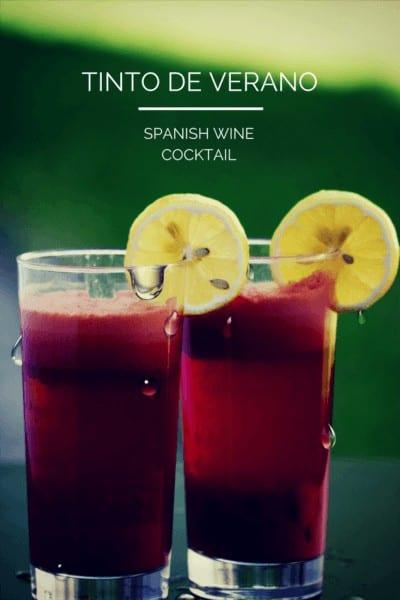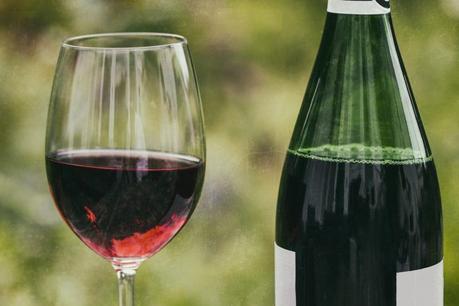I was introduced to tinto de verano on our first evening in Madrid.
Having asked the waiter to bring whatever liquid refreshment he recommended, I was a bit taken aback when he brought out a small glass with ice, a 4-ounce carafe of red wine, and a small bottle of some sort of clear, fizzy drink. That did not look at all appealing. Here I had been expecting him to bring out a glass of whatever flavorful local red wine he recommended-hopefully one of Spain's famous Riojas-and I was getting ice?
Well, far be it from me to refuse to try something different. Especially after I'd asked for his advice.
"How do I drink it?" I asked.
"You mix the two together in the glass. The flavor changes depending on how you mix it. Try different ways and see what you like. I will come back to see what you think." He nodded and walked away.
What is tinto de verano?

Literally, tinto de verano means "red wine of summer." Think of it as a red wine spritzer-except in Spain, it is much more popular than sangria! You'll find tinto de verano at most parties, festivals, and local bars.
The difference between tinto de verano and sangria is that traditional sangria includes a variety of fruits as well as ingredients such as brandy, sugar or simple syrup. Whereas tinto de verano is much less complex and is made of red wine, a fruity soft drink, and ice.
Well, it certainly looked refreshing. I examined the label on the fizzy drink in question: La Casera gaseosa. Nope, it didn't look familiar, so ... I poured half a glass of red wine, filled the rest with this gaseosa stuff, and took a sip of my icy creation. It was slightly sweet, with a strong grapey flavor and just a hint of red wine. "Oh, wow," I told Dan, "I think I like this more than sangria."
He looked at me, doubtful. "Try it," I offered. Like me, he loved it at first sip. I made a mental "Note to Self:" Learn how to make tinto de verano at home. Must. Drink. This. Again.
ⓘ TIP: If you're on a budget, always go for tinto de verano instead of sangria.Spaniards know tourists are familiar with sangria, so restaurants sell it at a higher price. Not only is tinto de verano far more affordable than sangria, but it's also easier to drink in volume.
Tinto de Verano vs. Sangria: What's the Difference?
You might be wondering, "Isn't tinto de verano just another name for sangria?" Not quite! While both are refreshing Spanish wine drinks, they're actually quite different.
Let's break it down:
Tinto de Verano is the laid-back cousin of sangria. It's simple, quick, and oh-so-refreshing, like a lazy summer afternoon in a glass. It's just red wine and lemon-lime soda, served over ice. Easy peasy!
Sangria, on the other hand, is the life of the party. It's got more going on-wine, fruit, maybe some brandy-and it likes to hang out in the fridge for a while to let all those flavors mingle. It's the drink you make when you want to impress your friends at a party.
Here's a fun fact: while tourists often go crazy for sangria, it's tinto de verano that you'll see locals sipping at cafes and bars across Spain. It's like their secret weapon against the summer heat.
So, when should you choose one over the other? Go for tinto de verano when you want something light and easy. It's perfect for day drinking (we won't tell) or when you're in the mood for a quick, refreshing drink. Opt for sangria when you're feeling fancy or have some time to prep before a gathering.
Honestly, both drinks are delicious in their own right. The best one is whichever you're in the mood for!
How to Make Tinto de Verano: A Simple Recipe
This Spanish cocktail is far simpler than making sangria. It contains only two ingredients, unless you count the ice and lemon slice that's used as a garnish.
To make tinto de verano, you simply mix 1 part of red table wine and 1 part gaseosa. Start with equal parts, then adjust to taste. Any red table wine will work (mine was rioja, a Spanish wine that's made from cabernet sauvignon grapes). So will any gaseosa.
Gaseosa is a general term for carbonated drinks. The preferred mixer is La Casera, a lightly-sweetened, lemon-flavored soda. The best La Casera alternative is Sprite, though I personally think Sprite is sweeter.
In the US or UK, La Casera is available on Amazon.
What kind of wine is best for Tinto de Verano? It really doesn't matter what type of red wine you use. You don't have to use your best wine, just use a decent table wine. Just keep in mind: If the wine isn't drinkable on its own, then don't use it in a punch or cocktail. (You don't want to end up with a bad hangover, do you?)
There's also a variety of tinto de verano made with orange soda, though I imagine it would be much sweeter. Then again, there's no accounting for taste, because Spaniards also mix red wine and cola. Fortunately for us all, that one goes by a different name!
Tinto de Verano
Inspired? Pin this post and share it with your friends!
Where to find tinto de verano in Spain

It didn't take long to realize that this Spanish wine cocktail is available everywhere in the summertime. When I asked a bartender at a Madrid tapas bar if he served tinto de verano, he looked offended. "Of course!" he responded, and rolled his eyes. Maybe he was shocked that I would think otherwise.
Me, the clueless tourist.
In any case, tinto de verano is a super refreshing red wine spritzer and a great alternative to sangria or wine the next time we have a party or sit by the pool. It's far more common at Spanish parties and bars, lower in alcohol and calories, much more affordable than its touristy sangria cousin, and a lot easier to make.
Tips for the Perfect Tinto de Verano Every Time
- Experiment with ratios: While equal parts wine and soda is standard, adjust to your taste preference.
- Choose your wine wisely: Use a decent table wine you'd enjoy on its own.
- Gaseosa alternatives: If La Casera isn't available, use Sprite or a mix of lemonade and soda water.
- Serve it ice cold: Always use plenty of ice for the most refreshing experience.
- Try variations: Experiment with orange soda for a sweeter version, or add a splash of vermouth for extra complexity.
- Garnish creatively: While lemon or orange slices are traditional, try adding mint leaves for a fresh twist.
- Make it in batches: For parties, mix the wine and soda in a pitcher just before serving to maintain carbonation.

